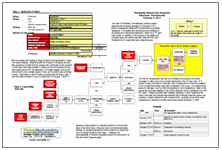A pipeline spill in Alberta, Canada of up to 480,000 litres was noticed on the evening of June 7, 2012. Although pipelines are estimated to spill approximately 3.4 million litres a year, they are not frequently near populated areas or water sources. However, due to the proximity of this spill to a drinking water source, there was the potential of impact to drinking water. An issue of this magnitude, with this type of impact, is thoroughly investigated to reduce the risk of recurrence. We can examine this issue in a visual root cause analysis performed as a Cause Map.
We begin with the impacts to the goals. In this case, the safety goal is impacted because of the potential impact to drinking water. The environmental goal is impacted because of the spill of sour crude oil. The spill is impacting area residents in a variety of ways, which can be considered an impact to the customer service goal. The production goal was impacted due to a 10-day shutdown of a portion of the pipeline. The property goal is impacted by the damage to the pipeline, and the labor goal is impacted by the response and cleanup required.
 Once we have developed the impacts to the goals, we can ask “Why” questions to develop the cause-and-effect relationships that resulted in those impacts. The potential impact to drinking water resulted from the proximity of the spill to a drinking water source, because the spill was in a populated area, and the oil spill itself. The oil spill resulted from damage to the pipeline and the time elapsed before the spill was stopped. Because the longer a spill goes undetected, the more environmental impact it has, consideration of the adequacy of monitoring, inspection and testing must be considered to ensure that this risk is reduced.
Once we have developed the impacts to the goals, we can ask “Why” questions to develop the cause-and-effect relationships that resulted in those impacts. The potential impact to drinking water resulted from the proximity of the spill to a drinking water source, because the spill was in a populated area, and the oil spill itself. The oil spill resulted from damage to the pipeline and the time elapsed before the spill was stopped. Because the longer a spill goes undetected, the more environmental impact it has, consideration of the adequacy of monitoring, inspection and testing must be considered to ensure that this risk is reduced.
Although the cause of the pipeline damage is still being investigated, causes that have resulted in prior pipeline damage include construction damage, internal corrosion, and external corrosion. External corrosion can result from exposure to water, which in this case was impacted by recent flooding of the river and shallow burying of the pipe, as was typical with earlier installations. The age of the pipe may have also impacted the internal corrosion, as the more time that pipe is exposed to hydrocarbons (which the pipe transmits) the more corrosion will occur.
Immediate solutions include isolating the damaged area with a valve. Then repairs were made to the pipeline, and cleanup began. Cleanup is expected to take most of the summer. There have been calls for increased monitoring, testing, and inspection of the line, and with an incident of this type, that frequency should be examined to ensure it is appropriate to minimize these types of risk.
To view the Outline, Cause Map, and Solutions, please click “Download PDF” above.



